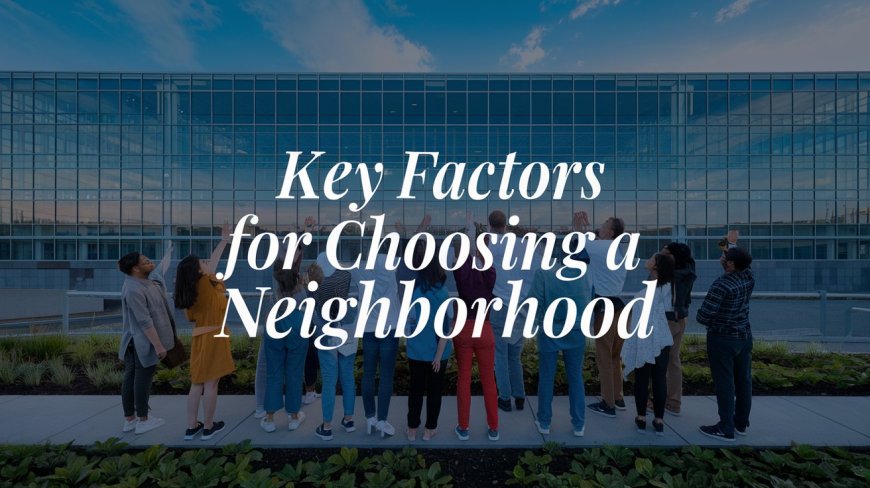Key Factors for Choosing a Neighborhood
Discover essential tips for choosing the right neighborhood. Learn about safety, amenities, and lifestyle to find your perfect community.

Finding the perfect neighborhood can feel like a daunting task. After all, your neighborhood greatly impacts your quality of life, from your family's safety to your daily commute and sense of community. Whether you're planning to buy a home or simply want a better understanding of what makes a neighborhood desirable, knowing the key factors to evaluate can simplify the process. From proximity to amenities and work to the atmosphere and housing options, these considerations ensure you make a well-informed decision. Additionally, factors like future growth potential, walkability, and access to quality schools play an integral role in shaping a neighborhood’s appeal.
1. Safety and Security
Safety tops the list for most homebuyers and renters. No matter how attractive a neighborhood may seem, understanding its safety measures is vital for your peace of mind.
-
Research crime statistics from reputable sources such as local law enforcement websites or online crime mapping tools.
-
Look for well-maintained streets with proper lighting, functional sidewalks, and visible security systems.
-
Check the proximity to emergency services like hospitals, police stations, and fire departments.
-
Visit the neighborhood at different times of the day to get a sense of its environment.
Pro Tip: Neighborhoods with active community watch programs often feel safer and more connected.
2. Quality of Schools
If you have children or plan to start a family, the quality of local schools can significantly impact your choice of neighborhood. Even if you don’t have school-aged children, being in a high-performing school district often increases property values.
-
Look up school ratings on platforms like GreatSchools.org or state education websites.
-
Investigate the availability of extracurricular activities, arts programs, and sports teams.
-
Consider nearby daycare centers and preschool options if applicable.
3. Proximity to Work and Amenities
Your daily commute and access to essential services can greatly influence your satisfaction with a neighborhood.
-
Evaluate commute times during peak hours and assess public transportation options.
-
Ensure key amenities such as grocery stores, healthcare facilities, and pharmacies are conveniently located.
-
Check for recreational spaces, such as parks, gyms, and entertainment hubs.
-
If you’re looking for urban vibrancy, neighborhoods like those with apartments for sale in the upper west side often offer an excellent blend of accessibility and modern conveniences.
4. Community Atmosphere and Lifestyle
Every neighborhood has its unique vibe, shaped by its residents, culture, and local activities.
-
Attend local events or community gatherings to get a sense of the neighborhood's spirit.
-
Look for signs of community pride, such as well-maintained yards, public art, and active neighborhood associations.
-
Consider your lifestyle preferences—whether you prefer a quiet suburb or a bustling urban environment.
5. Housing Market and Affordability
Understanding the housing market in your desired area ensures your decision aligns with your financial goals.
|
Factor |
Why It Matters |
How to Evaluate |
|
Property Values |
Indicates potential investment returns |
Check recent sales data in the area |
|
Property Types |
Aligns with your needs (apartments, houses) |
Browse local real estate listings |
|
Taxes & Costs |
Affects overall affordability |
Research property taxes and HOA fees |
|
Market Trends |
Shows future growth potential |
Look at long-term price trends |
Neighborhoods like the Upper West Side often combine vibrant housing options with consistent value growth, making them desirable for a wide range of buyers.
6. Future Development and Growth
A neighborhood’s prospects can greatly affect your quality of life and property investment.
-
Research upcoming infrastructure projects, like new roads, schools, or commercial developments.
-
Check for zoning changes that may alter the neighborhood’s character.
-
Assess economic indicators such as job growth and population trends.
Example: Urban neighborhoods with significant upcoming developments often see rapid appreciation in property values, making them ideal for investment.
7. Walkability and Transportation
If you prioritize convenience, a neighborhood’s walkability and access to public transportation are crucial.
-
Use tools like WalkScore.com to evaluate pedestrian accessibility.
-
Check for reliable bus, train, or subway systems nearby.
-
Observe traffic patterns to gauge congestion levels.
8. Environmental Considerations
Don’t overlook the environmental aspects of your prospective neighborhood.
-
Assess flood risks, air and water quality, and other natural hazard factors.
-
Proximity to parks or natural green spaces can enhance your outdoor activities.
-
Pay attention to noise pollution from airports, highways, or industrial areas.
9. Relevance of Upper West Side Apartments for Sale
For those interested in urban living, exploring options like Upper West Side apartments for sale can be an excellent choice. Known for its cultural richness, accessibility, and architectural charm, the Upper West Side attracts a diverse mix of families, professionals, and retirees.
-
The area offers a combination of modern amenities and classic appeal, with numerous parks, shopping centers, and entertainment venues.
-
Housing options range from luxury high-rises to more affordable co-ops, catering to various budgets and preferences.
10. Tips for Evaluating Neighborhoods
-
Visit at Different Times: Observe activity levels in the morning, afternoon, and evening.
-
Talk to Residents: Get insights on the pros and cons directly from people living there.
-
Use Online Tools: Explore platforms like Zillow or Realtor.com for property and neighborhood insights.
-
Hire a Realtor: A knowledgeable real estate agent can provide valuable guidance tailored to your preferences.
Conclusion
Choosing the right neighborhood requires balancing several factors, including safety, schools, accessibility, and housing affordability. By thoroughly researching these aspects, you can ensure your decision supports your lifestyle and long-term goals. Neighborhoods like the Upper West Side, with their blend of amenities and investment potential, highlight the importance of aligning personal priorities with the unique offerings of each area.
What's Your Reaction?





















![SAP C_LUMIRA_24 Exam Dumps [2024 Questions] For Perfect Study](https://news.bangboxonline.com/uploads/images/202410/image_430x256_6717475e9b950.jpg)